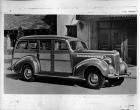|
Re: 1956 Clipper Hot Rod
|
||||
|---|---|---|---|---|
|
Forum Ambassador
|
Quote:
I thought getting all 12 volts to the ignition was always a good thing, especially when starting
Posted on: 2009/10/17 13:23
|
|||
|
||||
|
Re: 1956 Clipper Hot Rod
|
||||
|---|---|---|---|---|
|
Webmaster
|
The forth terminal bypasses the ballast resistor and supplies 12v to the coil during for easier starting, and then shuts off after you lay off the starter. Once started the coil is running on basically 6 volts from the ballast resistor output to prevent the points from getting burned up during normal operation. That is why the 6volt cars don't have a ballast resistor.
Posted on: 2009/10/17 13:27
|
|||
|
-BigKev
1954 Packard Clipper Deluxe Touring Sedan -> Registry | Project Blog 1937 Packard 115-C Convertible Coupe -> Registry | Project Blog |
||||
|
||||
|
Re: 1956 Clipper Hot Rod
|
||||
|---|---|---|---|---|
|
Webmaster
|
Howard we always seam to meet like this! lol
Posted on: 2009/10/17 13:28
|
|||
|
-BigKev
1954 Packard Clipper Deluxe Touring Sedan -> Registry | Project Blog 1937 Packard 115-C Convertible Coupe -> Registry | Project Blog |
||||
|
||||
|
Re: 1956 Clipper Hot Rod
|
||||
|---|---|---|---|---|
|
Home away from home

|
Not necessary meaning the car will start reliably without it. What happens when you put on a 12V coil that's internally resisted? There's no bypass there and the car still starts every time, does it not?
Posted on: 2009/10/17 13:43
|
|||
|
||||
|
Re: 1956 Clipper Hot Rod
|
||||
|---|---|---|---|---|
|
Forum Ambassador
|
Point taken as a good condition car would probably not miss a lick whereas another with some issues might need the extra. Would also suspect other changes and efficiencies designed into a coil with internal resistor vs those with externals. Winding orientation, size, spacing, and even core metallurgy are some that come to mind for a more consistent output. Aren't most internals designed around a particular car or system?
Posted on: 2009/10/17 14:09
|
|||
|
||||
|
Re: 1956 Clipper Hot Rod
|
||||
|---|---|---|---|---|
|
Home away from home

|
Most of the "universal" 12V coils are internally resisted, which is what I always use when converting to 12V.
Posted on: 2009/10/17 14:17
|
|||
|
||||
|
Re: 1956 Clipper Hot Rod
|
||||
|---|---|---|---|---|
|
Home away from home

|
try starting the car in extremely cold weather of say zero degrees or less. Also a marginaly low battery condition can cause slow starting. In some cars there is a RESISTOR WIRE not a conspicuous porcelin resistor. Many GM cars used a resistor WIRE in place of the more conspicuous MoPar type resistor.
I'm not sure about this. but i believe the resistor wire was variable resistance depending on heat. I am sure that hte wire was constructed of a sequence of variations in the diameter of the core of the wire thus producing the resistance to the coil. Also note that most Chevies and maybe other GM makes ca. 1958 thru 1973'ish would start real fast but immediately die about 5 seconds after release of the key from start position. THis was often a problem even in NEW cars.
Posted on: 2009/10/17 14:22
|
|||
|
VAPOR LOCK demystified: See paragraph SEVEN of PMCC documentaion as listed in post #11 of the following thread:f
https://packardinfo.com/xoops/html/modules/newbb/viewtopic.php?topic_id=7245 |
||||
|
||||
|
Re: 1956 Clipper Hot Rod
|
||||
|---|---|---|---|---|
|
Home away from home

|
Come to think of it, i can not recall any production automobile WITH IGNITION POINTS that used an internaly resisted coil.
Posted on: 2009/10/17 14:35
|
|||
|
VAPOR LOCK demystified: See paragraph SEVEN of PMCC documentaion as listed in post #11 of the following thread:f
https://packardinfo.com/xoops/html/modules/newbb/viewtopic.php?topic_id=7245 |
||||
|
||||
|
Re: 1956 Clipper Hot Rod
|
||||
|---|---|---|---|---|
|
Home away from home

|
Quote:
try starting the car in extremely cold weather of say zero degrees or less. I used an internally resisted coil on my '56 Patrician and it started every time, even when it was -10F. There was no "resistor wire" or the like, and I didn't use the stock Packard resistor. It started first time, everytime, no matter what the temperature was. I've never had a problem using an internally resisted coil in any cay I've ever put one on. I used to put them on my old Mopar's to get rid of the worthless ballast resistor that they used. They always started every time, all the time. Sounds like a GM problem to me, as I've never had any trouble with them, and I don't own and haven't owned and will not own GM products.
Posted on: 2009/10/17 14:43
|
|||
|
||||









